Introducing 100 foods before your baby turns 1 year old has become a popular goal among parents. This approach encourages early exposure to a wide range of flavors, textures, and nutrients, helping children develop diverse eating habits. The idea is simple: during your baby’s first year, offer them a variety of foods to help expand their palate and prevent picky eating in the future. This article explores the benefits, tips, and suggested foods to achieve this exciting milestone.
Why Try 100 Foods Before 1?
Introducing a variety of foods before your baby’s first birthday has numerous benefits. This method helps:
- Develop Healthy Eating Habits: Babies exposed to different tastes early on are more likely to enjoy a wide range of foods as they grow.
- Prevent Picky Eating: A wide selection of foods reduces the risk of your baby becoming a picky eater.
- Introduce Allergens Safely: Gradually offering foods like peanuts or eggs allows your baby to build tolerance and lowers the chance of allergies.
The 100 foods before 1 strategy also promotes the development of motor skills as babies learn to chew, swallow, and handle different textures.
Must read Rosenberg Food Manufacturing
How to Start Introducing 100 Foods Before One
Begin With Single-Ingredient Foods
The key to starting is introducing one food at a time. Babies as young as six months can start with purees or soft, mashed foods. Begin with simple fruits like apples, bananas, or pears. Vegetables like sweet potatoes, carrots, and peas are also excellent choices. By introducing single-ingredient foods, you can monitor any potential allergic reactions and gradually expand their diet.
Add Proteins and Grains
Once your baby is comfortable with fruits and vegetables, move on to proteins and grains. Foods like chicken, turkey, and fish (make sure it’s boneless) are soft and easy to digest. Whole grains like oats, rice, and quinoa provide essential nutrients like fiber and vitamins, making them a healthy addition to your baby’s diet.

Introduce Dairy and Eggs
Around the 7 to 8-month mark, you can begin offering your baby small amounts of dairy, such as yogurt or cheese. Eggs are another nutrient-rich food. Start with the yolk, then introduce the whites, making sure your baby shows no signs of egg allergies. These foods offer proteins and fats that support your baby’s growth and brain development.
Planning the 100 Foods Before One Year List
Planning your list of 100 foods before 1 can feel overwhelming, but it doesn’t have to be. Here’s how you can organize your approach:
Focus on Food Groups
To ensure a balanced introduction of foods, divide the foods into categories like:
- Fruits and Vegetables: Offer a wide range of colors and textures to expose your baby to various tastes and nutrients.
- Proteins: Chicken, fish, lentils, and beans are great sources of protein.
- Grains: Quinoa, oats, rice, and barley provide essential carbohydrates and fibers.
- Dairy: Introduce dairy in small amounts, and always opt for full-fat versions.
Gradually Introduce Allergens
Introducing potential allergens like peanuts, tree nuts, shellfish, and eggs early and gradually can help build tolerance. It’s important to monitor your baby closely during this process. Always consult your pediatrician before introducing allergens, especially if your family has a history of food allergies.
Benefits of Introducing 100 Foods Before 1
Promotes Taste Development
Babies are naturally curious, and offering them various foods encourages an adventurous palate. The more flavors they are exposed to, the more likely they will enjoy different foods later in life. The 100 foods before one approach broadens their food experiences and helps prevent a preference for sweet, processed foods.
Encourages Nutrient Diversity
Introducing a wide range of foods ensures your baby gets essential nutrients from diverse sources. Different vegetables, grains, proteins, and fruits offer vitamins and minerals critical for healthy growth and development. This variety provides an essential foundation for balanced nutrition in the early years.
Builds Motor Skills
Introducing a range of textures—soft purees, mashed foods, and finger foods—helps babies develop their motor skills. Learning how to chew, swallow, and even handle foods with their fingers is an important developmental milestone that supports self-feeding skills as your baby grows.
Tips for Successfully Introducing 100 Foods Before One
Be Patient and Persistent
Introducing new foods requires patience. Your baby may not always like a food the first time, but this doesn’t mean they’ll never enjoy it. Sometimes it takes multiple tries before a baby accepts a new taste. Keep offering a variety of foods in different forms, and eventually, they may grow to love them.
Make Mealtime Fun
Turn mealtime into an enjoyable experience by offering foods in fun shapes or bright colors. Use safe baby utensils and encourage self-feeding with finger foods. This will help your baby associate food with positive experiences and make them more open to trying new things.
Keep a Food Journal
Keeping track of the foods you introduce will help you ensure variety and monitor any reactions. A food journal is also a great way to see how close you are to reaching the 100 foods milestone.

Common Concerns with 100 Foods Before 1
Allergies
One of the biggest concerns parents have is the potential for allergies. Introducing allergenic foods in small amounts and watching for reactions is key. If your baby shows signs of a food allergy (hives, vomiting, swelling), consult your pediatrician immediately.
Choking Hazards
Another common concern is choking. Make sure all foods are cut into small, manageable pieces and are soft enough for your baby to chew and swallow easily. Avoid hard foods like whole nuts, raw carrots, or large chunks of fruit, as they can pose a choking risk.
Sample List of 100 Foods Before 1
Here’s a sample of what your list of 100 foods before 1 might look like:
- Apples
- Bananas
- Sweet potatoes
- Carrots
- Avocados
- Blueberries
- Spinach
- Chicken
- Lentils
- Yogurt
- Eggs
- Oatmeal
- Salmon
- Zucchini
- Mangoes
…and the list goes on! You can customize the foods based on what’s available in your region and your baby’s preferences.
Conclusion
Achieving 100 foods before 1 is a fun and rewarding challenge for both you and your baby. By gradually introducing a variety of foods, you’re setting the foundation for healthy eating habits that will benefit them throughout life. Remember, every baby is different, so take your time and enjoy this exciting journey. With patience and persistence, you’ll soon reach the 100 foods milestone! If you want to read more information then visit here.

What is the best age to start introducing solid foods?
Most babies are ready to start trying solids around six months old. This is when they can typically sit up and show interest in what others are eating.
Can I introduce spices to my baby?
Yes! You can start adding mild spices like cinnamon, garlic, or cumin to your baby’s food to enhance flavor and introduce them to different tastes.
What if my baby doesn’t like a certain food?
It’s normal for babies to reject a food initially. Continue offering it in different forms over time, as they may develop a taste for it later on.
How should I introduce allergenic foods?
Introduce allergenic foods like eggs or peanuts in small amounts and watch for any allergic reactions. Consult your pediatrician for guidance, especially if allergies run in your family.
Do I need to puree all the foods I introduce?
Not necessarily. You can start with purees for younger babies, but as they grow, you can introduce mashed, soft, or finely chopped foods to help them develop chewing skills.
